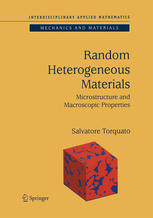

Most ebook files are in PDF format, so you can easily read them using various software such as Foxit Reader or directly on the Google Chrome browser.
Some ebook files are released by publishers in other formats such as .awz, .mobi, .epub, .fb2, etc. You may need to install specific software to read these formats on mobile/PC, such as Calibre.
Please read the tutorial at this link: https://ebookbell.com/faq
We offer FREE conversion to the popular formats you request; however, this may take some time. Therefore, right after payment, please email us, and we will try to provide the service as quickly as possible.
For some exceptional file formats or broken links (if any), please refrain from opening any disputes. Instead, email us first, and we will try to assist within a maximum of 6 hours.
EbookBell Team

0.0
0 reviewsThe study of random heterogeneous materials is an exciting and rapidly growing multidisciplinary endeavor. This field demands a unified rigorous means of characterizing the microstructures and macroscopic properties of the widely diverse types of heterogeneous materials that abound in nature and synthetic products. This book is the first of its kind to provide such an approach. Emphasis is placed on foundational theoretical methods that can simultaneously yield results of practical utility.
The first part of the book deals with the quantitive characterization of the microstructure of heterogeneous materials. The second part of the book treats a wide variety of macroscopic transport, electromagnetic, mechanical, and chemical properties of heterogeneous materials and describes how they are linked to the microstructure of model and real materials. Contemporary topics covered include the statistical mechanics of many-partical systems, the canonical n-point correlation function, percolation theory, computer-simulation methods, image analyses and reconstructions of real materials, homogenization theory, exact property predictions, variational bounds, expansion techniques, and cross property relations.
This clear and authoritative volume will be of particular interest to graduate students and researchers in applied mathematics, physics, chemistry, material sciences, engineering, geophysics, and biology. Moreover, the book is self-contained and approachable by nonspecialist.
Salvatore Torquato is a professor in the Department of Chemistry and in the Materials Institute at Princeton University. He also holds affiliated appointments at Princeton University in applied and Computational Mathematics Program and in Chemical Engineering. Among other honors, he was a John Simon Guggenheim Fellow in 1998. He has published over two hundred journal articles across a variety of scientific disciplines.